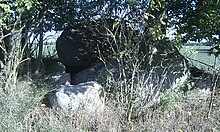Large dolmen from Sassen
The large dolmen of Sassen with the Sprockhoff numbers. 527, 528, 530, 532 and 533 were excavated by Ewald Schuldt in 1968 . The five megalithic complexes are located in rolling stone hills and were built between 3500 and 2800 BC. BC as large stone graves of the funnel beaker culture (TBK).
They are located east of Sassen near Loitz in the Vorpommern-Greifswald district in Mecklenburg-Western Pomerania . Two more, but not examined and more heavily damaged facilities are in the area: Sassen 3 (Spr.-No. 529) ▼ and Sassen 5 (Spr. No. 531). ▼
Großdolmen Sassen 1 (Spr.-No .: 527)
This north-east-south-west oriented, 1.4 m high system ▼ is a 5.0 m long and 1.8 m wide, well-preserved large dolmen with anteroom. All seven bearing stones are still there. One of the four cap stones lies on the north chamber. He carries seven bowls . All stones are missing in the access area. The vestibule, delimited on one side with granite slabs, is thus openly visible. The hall consists of red sandstone slabs. Due to the large number of reading stones, the dolmen makes a neglected impression. Apart from seven broken fragments and a sheeter , the complex contained no finds.
Großdolmen Sassen 2 (Spr.-No .: 528)
This north-east-south-west oriented, 1.4 m high system ▼ is a 4.0 m long and 2.0 m wide, well-preserved large dolmen with an anteroom and 0.7 m long corridor. The nine bearing stones of the chamber and an overlying capstone are in situ . One lies broken in the chamber. Fragments of a third capstone are in and next to the chamber. One of the cap stones carries 18 and the other 44 small bowls . The trapezoidal antechamber in the southwest divides the narrower access area. By Ausfeuerung red annealed board consists of red sand stone and coating of mud . The plant is disturbed by dense vegetation. It was reused by the bearers of the individual grave culture , the Elb-Havel group and the spherical amphora culture .
In addition to corpse burns, charcoal and 95 broken pieces, 12 cross cutters , six blades , four double-conical vessels, four spherical amphorae, two flat axes, two scrapers, two small chisels, two amber beads , two shoulder vessels , two tall pots, an ax with a bent neck, a heart-shaped arrowhead, a striking stone , a drill, a wide-mouthed vessel and a wide-mouthed pot come to light.
Großdolmen Sassen 4 (Spr.-No .: 530)
This north-east-south-west oriented 1.4 m high complex ▼ is a 4.75 m long and 2.0 m wide, well-preserved large dolmen with an anteroom. All eight bearing stones are still there. One of the two cap stones is tipped into the chamber on one side. All bearing stones and the capstone at the southern end of the chamber are missing in the access area. The anteroom, which is delimited with granite slabs between the pairs of wall stones, is thus open to view. The red-annealed plank consists of red sandstone slabs. The facility was reused by the bearers of the individual grave culture .
In addition to corpse burns, charcoal and 75 pieces of broken glass, eight sheeters , six blades , two tall pots, an amber bead , a flat hatchet, a hammer , an ax with a bent neck, a bowl and a rock ax were found during the excavation .
Großdolmen Sassen 6 (Spr.-No .: 532)
This north-east-south-west oriented, 1.4 m high complex ▼ is a 4.8 m long and 1.4 m (in the front area 1.1 m) wide, well-preserved large dolmen with anteroom. All bearing stones and three of the four cap stones of the chamber are in situ . The corridor capstone is missing. The bearing stones are hidden in the ground. The red-annealed plank consists of red sandstone slabs and clay screed. The facility was reused by the bearers of the individual grave culture , the Elb-Havel group and the spherical amphora culture .
In addition to corpse burns, charcoal and 85 shards, 13 cross cutters , five blades , three amber beads (one double-axed), three flat hatchets, two hammer stones , two spherical amphorae, a spherical bowl and an ax with a bent neck were found during the excavation .
Großdolmen Sassen 7 (Spr.-No .: 533)
This north-east-south-west oriented, 1.5 m high complex ▼ is a 4.4 m long and 2.1 m (in the front area 1.5 m) wide, well-preserved large dolmen with anteroom. All nine bearing stones and the three cap stones of the chamber are in situ . The corridor capstone is missing. The red-glowed plank consists of clay screed. No finds were made.
See also
literature
- Luise Lorenz: Ceramic lifetimes and the useful life of northeast German megalithic graves. In: Martin Hinz, Johannes Müller (eds.): Settlement, trench works, large stone grave. Studies on the society, economy and environment of the funnel cup groups in northern Central Europe (= early monumentality and social differentiation. Volume 2). Rudolf Habelt Verlag, Bonn 2012, ISBN 978-3774938137 , pp. 61-86 ( online ).
- Ewald Schuldt : Dolmen landscape on the Schwinge, Schwerin 1970.
- Ewald Schuldt: The large dolmen of Sassen, Demmin district. In: Ground monument maintenance in Mecklenburg. Yearbook 1970. 1971, pp. 19-63.
- Ewald Schuldt: The Mecklenburg megalithic graves. German Science Publishing House, Berlin 1972.
- Ernst Sprockhoff : Atlas of the megalithic tombs of Germany. Part 2: Mecklenburg - Brandenburg - Pomerania. Rudolf Habelt Verlag, Bonn 1967, pp. 78–79.
Individual evidence
- ↑ This in Mecklenburg-Vorpommern frequently encountered stone cover (no cairn or Röse ) is a thin layer of stone pebbles on a mound, which prevent erosion or the optics should impart a stone hill


